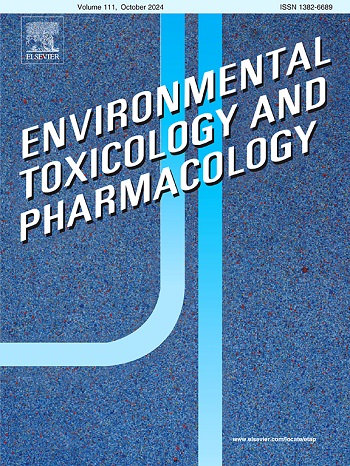血液对地铁铁纳米颗粒的反应。
IF 4.2
3区 环境科学与生态学
Q2 ENVIRONMENTAL SCIENCES
引用次数: 0
摘要
在这项研究中,我们研究了来自地铁不同位置的富铁纳米颗粒对血液中先天免疫系统的影响。纳米颗粒由三轨、轨道和车轮材料生成,并使用几种技术进行表征。用ELISA和毛细管免疫电泳分析人全血模型的反应。所有纳米颗粒都是氧化铁,但三轨纳米颗粒也含有硅,并且具有高度的血栓炎症、激活因子xi诱导的凝血和促炎的钾likrein/激肽途径。Wheel和Rail纳米颗粒反应性较低,主要激活钾激肽/激肽通路,导致较轻的炎症反应。三轨纳米颗粒的强血栓炎症特性归因于它们的高硅含量。这些纳米颗粒都没有显著激活补体系统。总之,我们发现纳米颗粒的元素组成是决定激活是否导致钾激肽/激肽系统激活和缓激肽释放或因子XI激活和血栓形成的关键。本文章由计算机程序翻译,如有差异,请以英文原文为准。
The blood response to subway-derived iron nanoparticles
In this study, we investigated the impact of iron-rich nanoparticles derived from different locations in the subway on the innate immune system in blood. Nanoparticles were generated from Third Rail, Rail, and Wheel materials and characterized using several techniques. The response in a human whole-blood model was analyzed using ELISA and capillary immunoelectrophoresis. All nanoparticles were iron oxides, but Third Rail nanoparticles also contained Silicon and were highly thrombo-inflammatory, activating Factor XI-induced coagulation and pro-inflammatory kallikrein/kinin pathways. Wheel and Rail nanoparticles were less reactive, mainly activating the kallikrein/kinin pathway, leading to milder inflammatory reactions. The strong thrombo-inflammatory properties of Third Rail nanoparticles are attributed to their high Silicon content. None of the nanoparticles significantly activated the complement system. In conclusion, we found that the elemental composition of nanoparticles is crucial in determining whether activation leads to kallikrein/kinin system activation and bradykinin release or Factor XI activation and thrombosis.
求助全文
通过发布文献求助,成功后即可免费获取论文全文。
去求助
来源期刊
CiteScore
7.00
自引率
4.70%
发文量
185
审稿时长
34 days
期刊介绍:
Environmental Toxicology and Pharmacology publishes the results of studies concerning toxic and pharmacological effects of (human and veterinary) drugs and of environmental contaminants in animals and man.
Areas of special interest are: molecular mechanisms of toxicity, biotransformation and toxicokinetics (including toxicokinetic modelling), molecular, biochemical and physiological mechanisms explaining differences in sensitivity between species and individuals, the characterisation of pathophysiological models and mechanisms involved in the development of effects and the identification of biological markers that can be used to study exposure and effects in man and animals.
In addition to full length papers, short communications, full-length reviews and mini-reviews, Environmental Toxicology and Pharmacology will publish in depth assessments of special problem areas. The latter publications may exceed the length of a full length paper three to fourfold. A basic requirement is that the assessments are made under the auspices of international groups of leading experts in the fields concerned. The information examined may either consist of data that were already published, or of new data that were obtained within the framework of collaborative research programmes. Provision is also made for the acceptance of minireviews on (classes of) compounds, toxicities or mechanisms, debating recent advances in rapidly developing fields that fall within the scope of the journal.

 求助内容:
求助内容: 应助结果提醒方式:
应助结果提醒方式:


